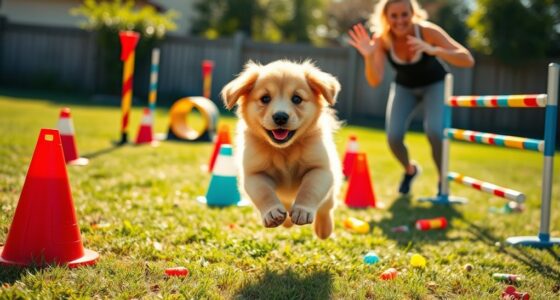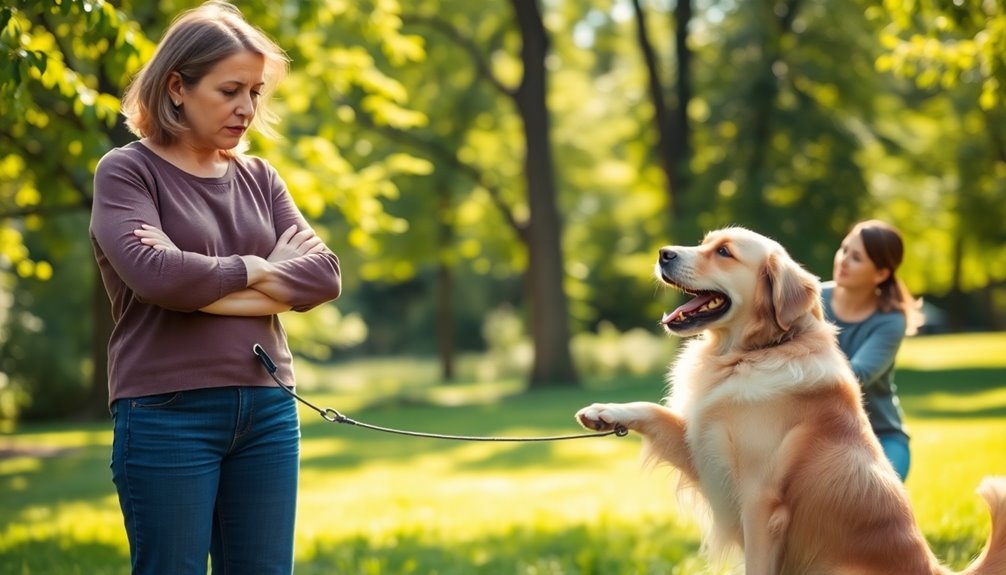To end leash pulling once and for all, start by establishing yourself as the leader during walks. Use techniques like stopping when the leash is tight and rewarding your dog for walking beside you with a loose leash. Consistency is key—maintain a calm demeanor and reinforce positive behavior immediately. If your dog pulls, redirect with a U-turn or a stop cue to regain focus. Equip yourself with tools like front-attach harnesses for better control. By committing to these strategies, you'll foster better walking habits, and there's more you can explore to build on your success.
Key Takeaways
- Establish clear leadership by exiting the house first and using consistent go signals to indicate when to start walking.
- Implement the stopping technique: halt movement when the leash is tense to regain your dog's focus and encourage loose leash walking.
- Use positive reinforcement to reward your dog for walking beside you with a loose leash, enhancing their motivation for desired behavior.
- Gradually introduce training tools like front-attaching harnesses or head halters for better control during walks while ensuring your dog is comfortable with them.
- Engage in consistent practice, gradually exposing your dog to distractions to reinforce focus and improve their leash manners over time.
Understanding Leash Pulling Behavior
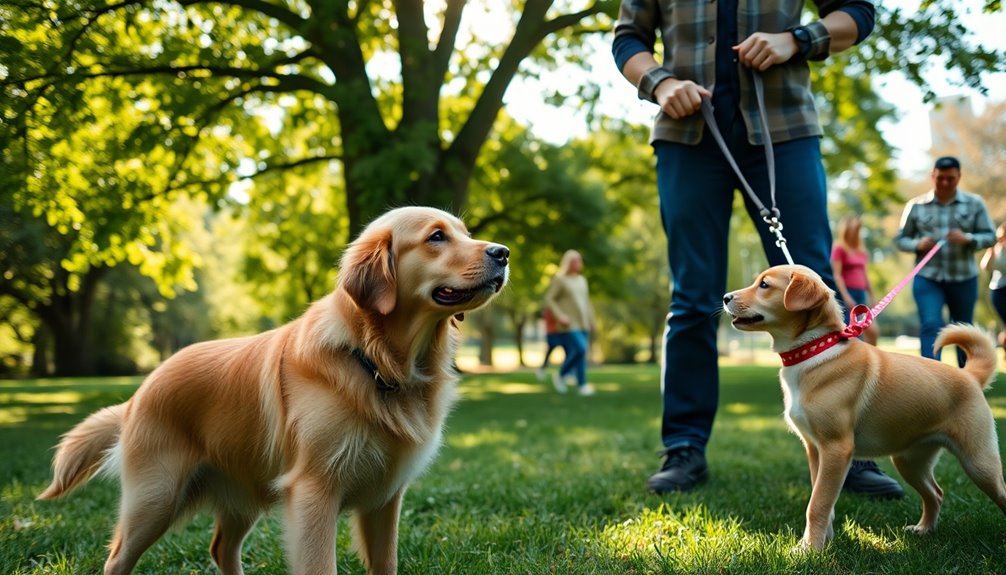
Leash pulling behavior is a common issue many dog owners face, and it often stems from a dog's natural instincts. Dogs are wired to explore their surroundings, driven by curiosity and a keen sense of smell. When you're out for a walk, they may be more interested in following scents than walking alongside you. This instinct can lead to dog pulling, as they attempt to take the lead and dictate the pace.
It's essential to understand that your dog might see themselves as the leader during these walks. When they pull, they might believe they're in charge, which can disrupt the owner-dog relationship. Excitement before walks can amplify this behavior, making clear leadership from you an important part of the solution.
Training your dog to understand proper leash manners isn't just about corrections; it's about establishing good behavior through consistent guidance.
Essential Training Techniques
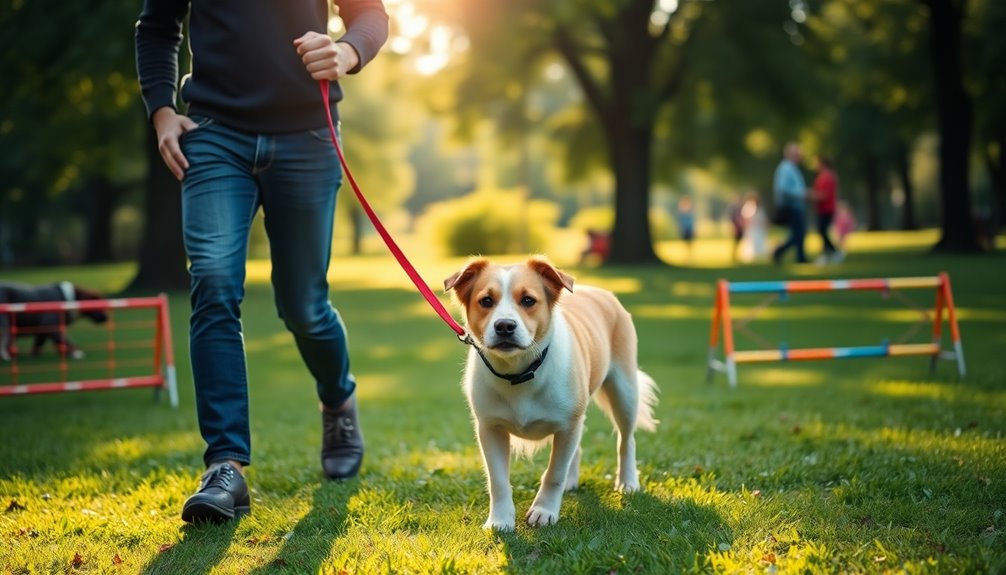
To effectively curb leash pulling, you'll want to adopt a few essential training techniques that promote better walking habits.
Start by implementing the stopping technique: when you feel tension on the leash, halt your movement. Only resume walking when the leash is slack, reinforcing the concept of a loose leash.
Another effective method is the corrective U-turn. If your dog starts to pull, redirect their attention by turning away, creating slack in the leash before you turn. This not only helps stop pulling but also keeps your dog focused on you.
Incorporate sudden stop cues to regain your dog's attention, using visual markers as reminders. When your dog looks at you, reward them with positive reinforcement, such as treats or praise, for walking beside you with a loose leash.
Additionally, explore various training tools like front-attaching harnesses or head halters. These can help redirect pulling behavior and give you better control during dog walking.
Preparing for Successful Walks
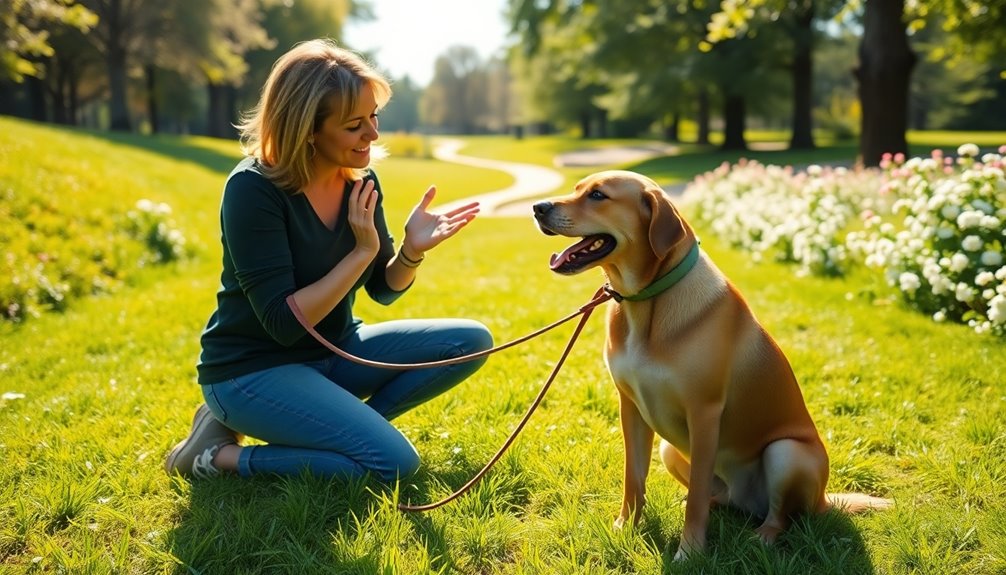
Starting your walk on the right foot is essential for setting the tone and ensuring your dog remains focused. To achieve this, exit your house first, preventing your dog from rushing out. This simple act establishes your authority from the start.
Before you begin, check your dog's behavior; if they seem overly excited, take a moment to regain their attention by using a calm demeanor.
When you're ready to start walking, use clear go signals to indicate when it's time to move. This reinforces your role as the leader and helps your dog understand when to follow.
If your dog starts pulling, remember that consistent consequences are vital. Don't allow pulling to dictate the pace or direction, as this undermines your authority. Instead, stop walking until your dog returns to your side and remains calm.
Tools and Equipment for Training
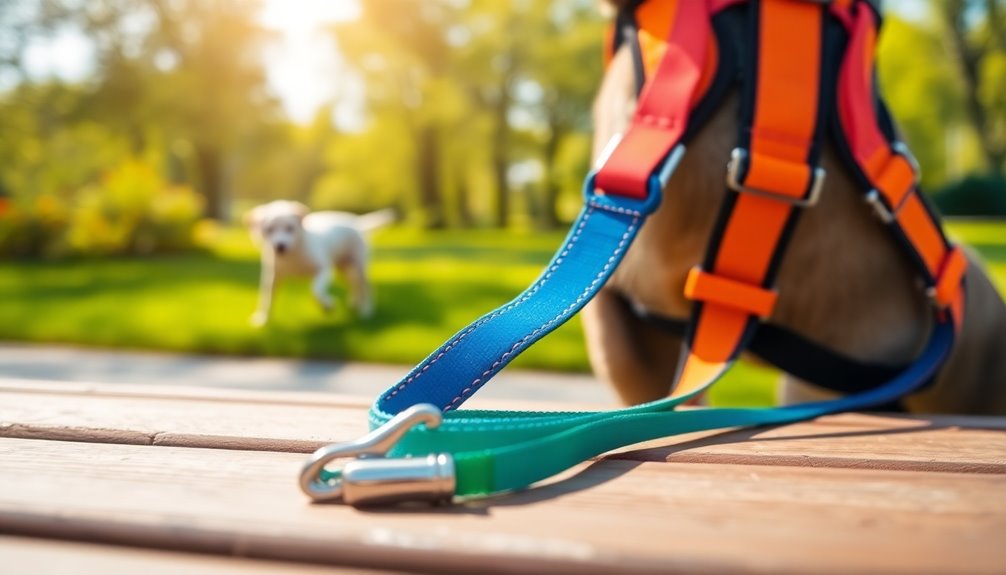
Choosing the right harness and leash can make a big difference in your dog's pulling behavior.
A properly fitted harness helps redirect their movement, while the right leash length gives you better control.
Let's explore how to select these tools effectively for your training.
Selecting Proper Harness Types
Selecting the right harness is crucial for effectively managing leash pulling in dogs. A front-attaching harness can be particularly effective, as it redirects your dog's pulling behavior by turning them back towards you.
When choosing a harness, make sure it fits well; you should be able to fit one to two fingers between the harness and your dog's skin. This prevents choking and discomfort during walks.
For dogs that pull lightly to moderately, the Doggy Dan No-Pull harness gently steers them back towards you, promoting better walking habits.
If you have a strong puller, consider using head halters like the Halti or Gentle Leader. These tools control your dog's head direction, making it easier to manage their pulling. However, remember to introduce them gradually to make sure your dog feels comfortable.
Using the correct training tools is crucial for positive reinforcement and long-term behavior change. The right harness can enhance your walking experience, making it more enjoyable for both you and your dog.
With patience and the proper equipment, you'll be well on your way to ending leash pulling once and for all.
Effective Leash Options Available
| Front-Attaching Harnesses | Redirect pulling by turning your dog toward you, ideal for light to moderate pullers. |
|---|---|
| Head Halters | Control head direction with options like Halti and Gentle Leader, promoting better focus. |
| Proper Fit | A snug but comfortable fit is key; verify one or two fingers fit between the collar/harness and your dog's skin. |
| Leash Length | A 4- to 6-foot leash provides the right balance of control and freedom for exploration. |
Utilizing these training tools will help you stop leash pulling effectively. As your dog becomes more accustomed to these options, you'll notice a remarkable change in behavior, leading to enjoyable walks together. Additionally, consistent commands during training sessions are crucial for clear communication and establishing good behavior.
Importance of Fit
Getting the fit right for your dog's harness and collar is essential for successful training and enjoyable walks. The importance of fit can't be overstated; a well-fitted harness prevents choking and discomfort, ensuring that your dog stays comfortable while you maintain control during walks. Properly fitted collars and harnesses should allow for one or two fingers' space, avoiding any risk of escape or injury.
Consider using a no-pull harness, like the Doggy Dan No-Pull harness, which gently steers your dog toward you, effectively redirecting pulling behavior. Head halters, such as the Halti and Gentle Leader, are also popular choices, as they control your dog's head direction, making it easier to manage pulling.
Remember that gradual acclimation to head halters or harnesses is vital. Introduce the equipment slowly, using distractions and treats to help your dog adjust comfortably. This approach won't only enhance your dog's experience but also improve your training results. Additionally, ensuring that your dog has a comfortable harness can contribute to a positive walking experience.
Positive Reinforcement Strategies
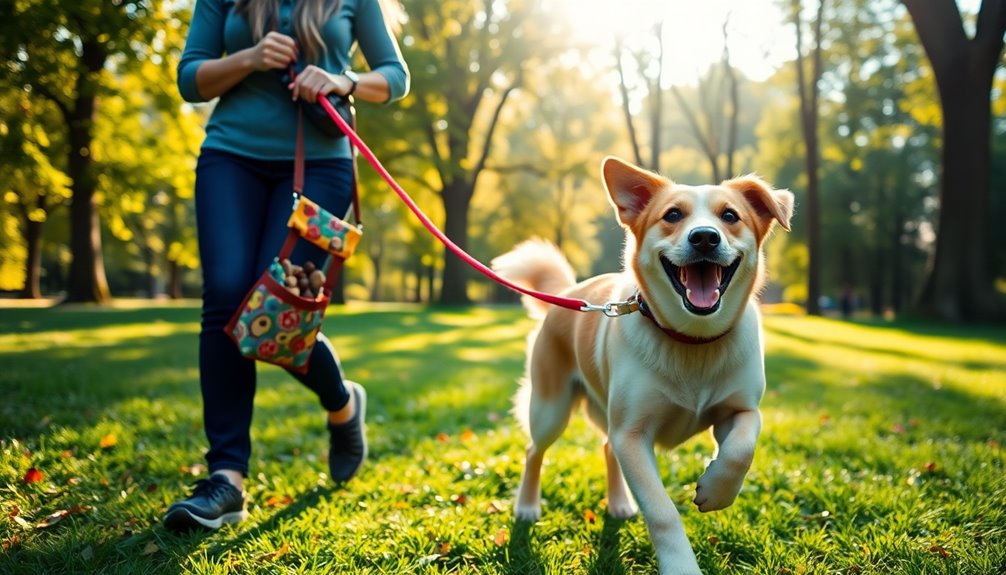
To effectively curb leash pulling, embracing positive reinforcement strategies can make all the difference in your dog's behavior. Focus on rewarding desired actions, like walking beside you with a loose leash. When your dog walks without pulling, immediately reward your dog with small treats, praise, or toys to create a positive association with this behavior.
Consistency is key—reward your dog every time they walk nicely during your training sessions. This reinforces the behavior and increases the likelihood of it being repeated in the future. Consider using a clicker or a verbal marker at the exact moment your dog behaves correctly. This helps clarify which action you're rewarding, making it easier for your dog to understand.
As your dog becomes more reliable, gradually fade out the treats while maintaining verbal praise. This keeps your dog motivated and focused on you, strengthening your bond.
Common Mistakes to Avoid
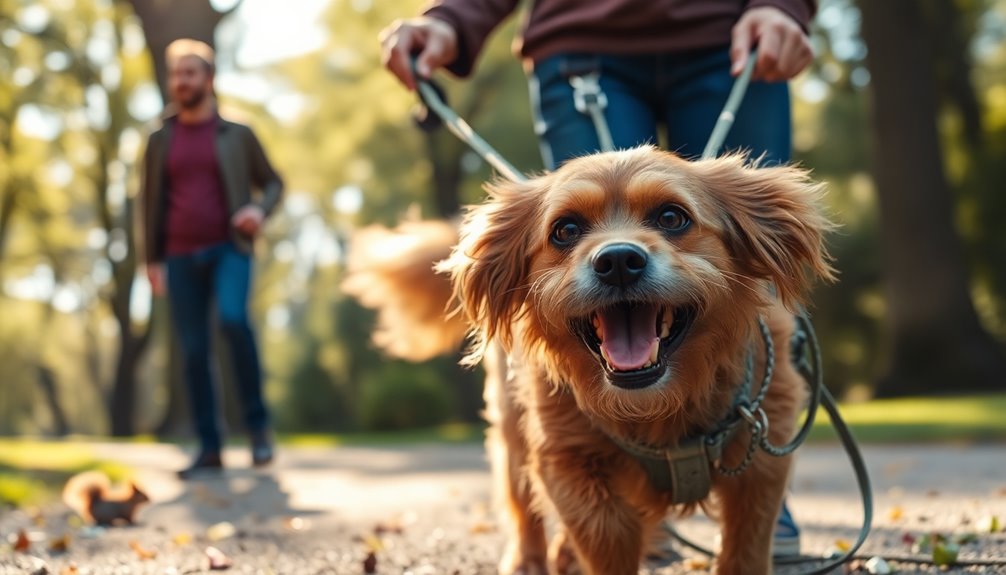
When it comes to leash training, consistency is key, and using punitive methods can actually backfire.
If you're not sticking to the same techniques every time, your dog won't understand what's expected, leading to more pulling.
Avoid harsh corrections too; they can create fear that only complicates the issue further.
Inconsistent Training Techniques
Inconsistent training techniques can create confusion for your dog, making it difficult for them to understand what's expected. If you occasionally stop when your dog pulls, you're sending mixed signals that can reinforce pulling behavior instead of correcting it.
To combat this, maintain a calm and assertive demeanor during walks; if you waver in your leadership, your dog may not recognize your authority.
Allowing your dog to control the pace or direction can also foster a habit of pulling. As they associate pulling with freedom or exploration, this behavior becomes ingrained.
It's essential to apply consistent consequences for pulling; if you sometimes correct and other times ignore it, your dog won't know how to behave.
Furthermore, a reliable reward system plays a significant role in your training process. If you don't consistently reward your dog for walking with a loose leash, you'll likely slow their progress.
Using Punitive Methods
Using punitive methods can be tempting for dog owners frustrated by leash pulling, but these approaches often backfire. Techniques like leash jerks or choke collars may lead to fear-based responses, worsening the pulling behavior and damaging your owner-dog relationship. Instead of enjoying your walks, you might find them stressful and chaotic.
Here's a quick comparison of the effects of punitive methods versus positive reinforcement:
| Training Technique | Effects |
|---|---|
| Punitive Methods | Fear, anxiety, increased aggression |
| Leash Jerks | Heightened reactivity to stimuli |
| Positive Reinforcement | Reliable behavior changes, trust building |
| Gentle Training Equipment | Encourages desired behaviors |
| Healthy Owner-Dog Relationship | Stress-free, enjoyable walks |
Research shows that dogs trained with positive reinforcement exhibit more consistent and sustained changes in behavior. By focusing on rewarding desired behaviors and using gentle training equipment, you can create a more effective learning environment. Avoid punitive methods; they're likely to create more problems than solutions.
Resources for Ongoing Support
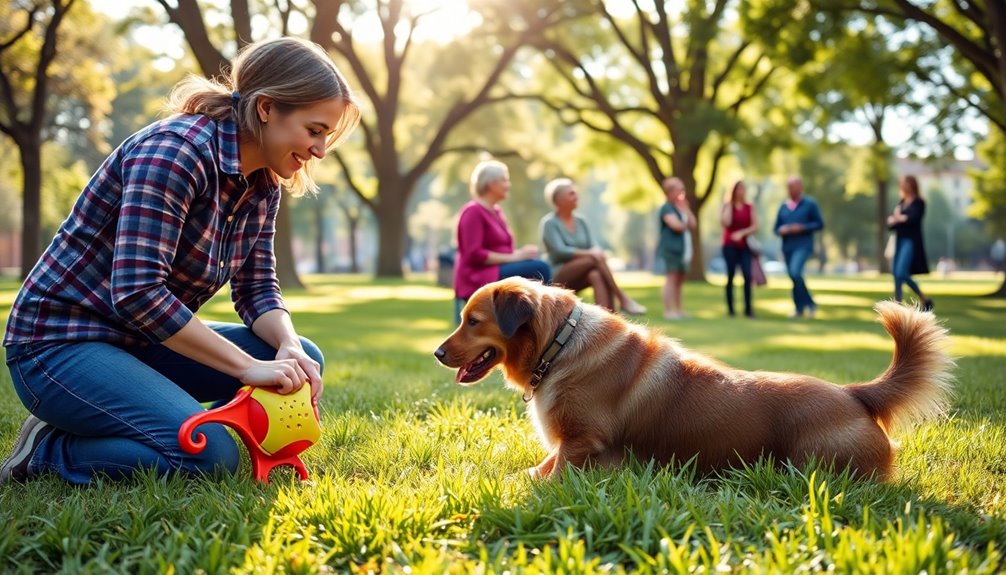
Finding ongoing support is essential for overcoming leash pulling challenges with your dog. One of the best ways to get this support is through online training programs, like those offered by Doggy Dan. These programs provide structured guidance and effective techniques specifically designed to address leash pulling.
You can also benefit from participating in community forums where you can connect with other dog owners facing similar issues. Sharing dog training tips and discussing successes can motivate you and help you find new strategies. Regular updates and educational resources are invaluable for keeping you informed about the latest training methods.
Additionally, consider engaging with local dog training classes or groups. These in-person sessions not only provide hands-on support but also create accountability, making your training experience more effective. Incorporating effective techniques can significantly improve your dog's walking behavior and enhance your overall experience.
Don't forget about downloadable PDF tips; they can serve as quick references to reinforce what you've learned.
Frequently Asked Questions
What Is the #1 Trick to Stop Your Dog From Pulling on the Leash?
The #1 trick to stop your dog from pulling on the leash is the "Stopping Technique."
When the leash gets tense, you immediately stop walking. Only resume when it's slack, reinforcing calm behavior. This teaches your dog that pulling doesn't get them anywhere.
You can also change direction when they pull, redirecting their focus back to you.
Consistency with these methods will help create a more enjoyable walking experience for both of you.
How to Stop Leash Pulling in 5 Minutes for a Puppy?
You might think you can magically stop leash pulling in just five minutes, but it takes patience and consistency.
Start by letting your puppy burn off some energy with a quick play session.
Then, use the stopping technique: halt each time the leash tightens and only move forward when it's slack.
Reward them with treats for walking calmly beside you, and remember to stay calm yourself—your energy influences their behavior considerably.
How to Make a No Pull Dog Leash?
To make a no-pull dog leash, start with a front-attachment harness that redirects your dog's pulling by turning them back towards you.
Use a training leash with a built-in shock absorber to minimize sudden pulls' impact.
A double-ended leash gives you better control, while a lightweight, padded leash guarantees comfort for both of you.
Aim for a leash that's 4 to 6 feet long to maintain control without limiting your dog's natural movement.
Do Dogs Grow Out of Leash Pulling?
Imagine your pup's excitement as you step outside, a bundle of energy ready to explore the world.
You might wonder if dogs grow out of leash pulling. Unfortunately, they often don't.
It's a learned behavior fueled by curiosity and excitement. Without consistent training and leadership from you, your dog may feel they're in charge during walks, leading to ongoing frustration for both of you.
Training's key to breaking this cycle!
Conclusion
To sum up, tackling leash pulling can transform your walks into enjoyable adventures. Did you know that nearly 80% of dog owners report struggles with leash pulling? By understanding your dog's behavior, using the right training techniques, and staying consistent, you'll both feel more connected and relaxed on your outings. Remember, patience is key, and with practice, you'll see progress. So, grab those training tools, keep a positive attitude, and enjoy the journey together!



